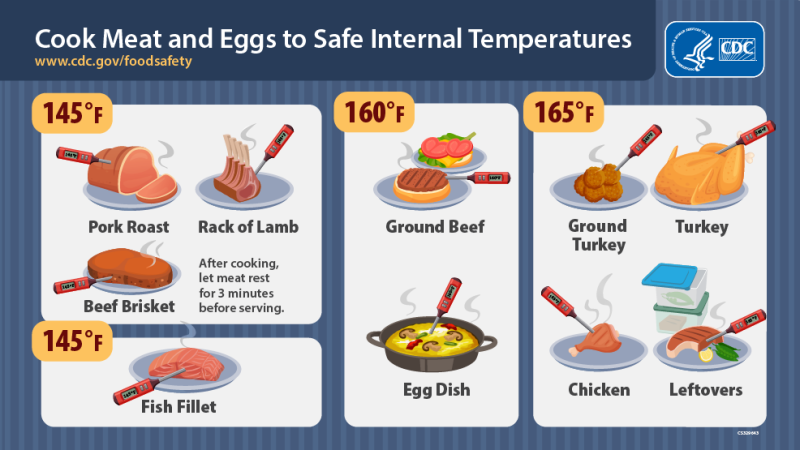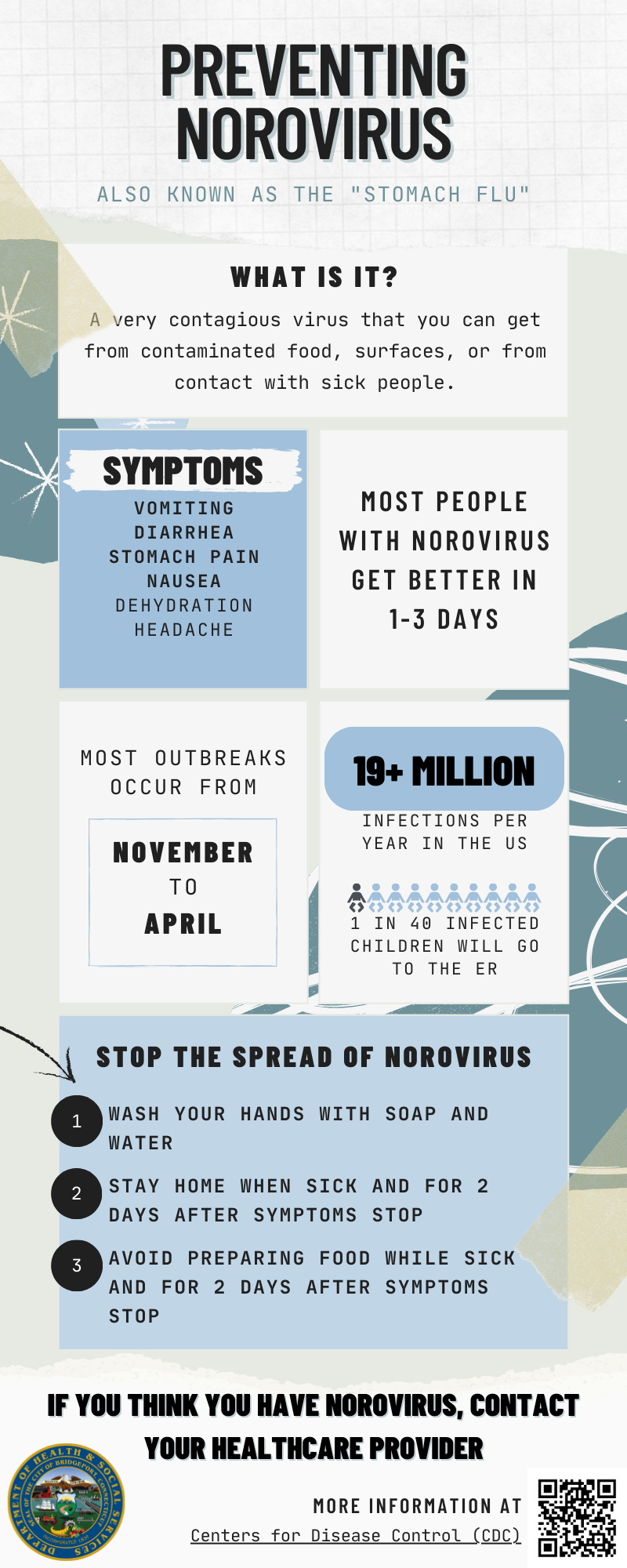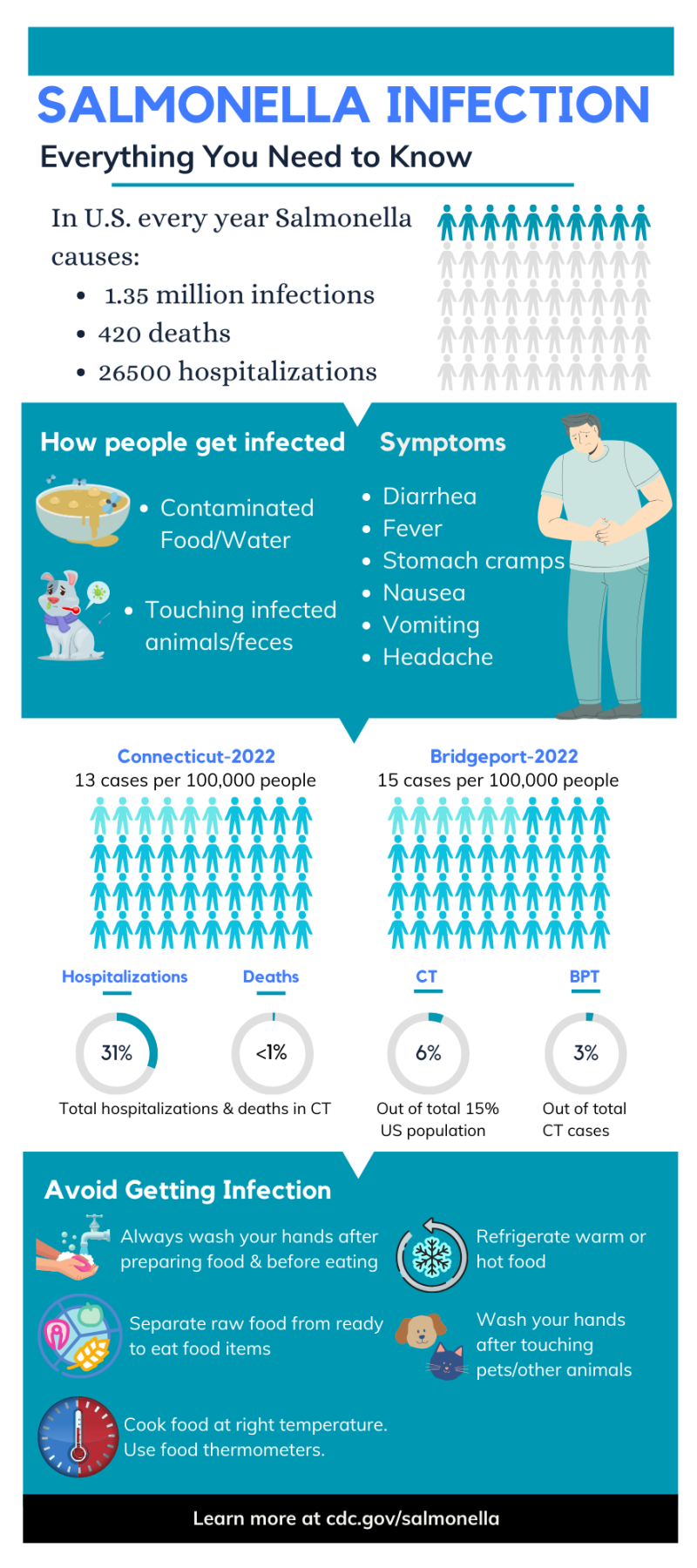Foodborne Illness
Foodborne illness, also known as food poisoning, is caused by consuming food or beverages contaminated with harmful bacteria, viruses, parasites, or toxins. This can lead to various symptoms, ranging from mild gastrointestinal discomfort to severe and life-threatening complications. Symptoms of foodborne illness can include nausea, vomiting, diarrhea, abdominal pain, fever, and, in severe cases, dehydration or organ failure. The severity of symptoms depends on factors like the type of contaminant, the amount consumed, and the individual's overall health.
Preventing foodborne illnesses involves practicing good food safety habits, including proper handwashing, thorough cooking, safe food storage, and avoiding cross-contamination. The Bridgeport Department of Health and Social Services and food establishments play a crucial role in ensuring the safety of the food supply through inspections and adherence to hygiene and sanitation standards.
If you think you have food poisoning, don't hesitate to contact your doctor for advice. If you get food poisoning, it's important to drink lots of fluids to prevent dehydration or help if you're a bit dehydrated. If vomiting is an issue, try sipping small amounts of clear liquids. Replacing lost fluids and electrolytes is the key treatment for food poisoning. You can find more information on food poisoning treatment at the NIH Website.
Foodborne Illness Summaries
Common Causes of Foodborne Illlness
Norovirus is a highly contagious virus that is a common cause of acute gastroenteritis, often referred to as the stomach flu or stomach bug. Norovirus is the most common cause of foodborne illness in the United States, causing an estimated 58% of all cases. While norovirus infections can happen at any time, they occur more often from November to April.
Norovirus is known for its ability to spread easily and cause outbreaks in various settings, including cruise ships, schools, nursing homes, and other places where people are in close quarters. The virus is primarily transmitted through the fecal-oral route, meaning it spreads when people come into contact with contaminated food, water, surfaces, or by direct person-to-person contact.
Norovirus infections typically involve symptoms lasting for a few days. However, the virus can be more severe and pose a greater risk to vulnerable populations such as the elderly, young children, and individuals with weakened immune systems.
Preventing norovirus infections involves practicing good hygiene, such as frequent handwashing with soap and water, especially after using the toilet and before handling food. Cleaning and disinfecting contaminated surfaces, avoiding the consumption of raw or undercooked shellfish, and staying home when sick are also important measures to prevent the spread of norovirus. You can find additional information on Norovirus on the CDC website or by contacting your medical provider.
Campylobacter is a type of bacteria that can make people sick. It belongs to a group of bacteria that are shaped like spirals and can thrive in places with low oxygen. The two main types that affect humans are called Campylobacter jejuni and Campylobacter coli. These bacteria are often found in the intestines of animals, especially in poultry, cows, and other livestock.
Getting sick from Campylobacter, known as campylobacteriosis, is pretty common and can happen when we eat contaminated food or drink contaminated water. This usually occurs when the food or water has come into contact with animal poop. Undercooked or contaminated meat, unpasteurized milk, and water that's not treated properly are common sources of infection.
To avoid getting sick with Campylobacter, it's important to cook meat thoroughly, especially poultry, and prevent the spread of bacteria by practicing good hygiene during food preparation. Drinking pasteurized milk and treating water from potentially contaminated sources can also help reduce the risk of infection. You can find additional information on Campylobacter at the CDC website or by contacting your medical provider.
Salmonella is a type of bacteria that can cause foodborne illness in humans. Salmonella bacteria can be found in the intestines of animals, birds, and reptiles. There are various strains of Salmonella, and they can cause a range of symptoms in people.
Salmonella infections, known as salmonellosis, typically occur when individuals consume contaminated food or water. Common sources of Salmonella contamination include raw or undercooked eggs, poultry, meat, and unpasteurized dairy products. Fruits and vegetables can also become contaminated if they come into contact with animal feces or contaminated water during the growing or harvesting process.
Preventing Salmonella infection involves proper food handling and cooking practices. This includes thoroughly cooking poultry and eggs, avoiding the consumption of raw or undercooked eggs, and practicing good hygiene in the kitchen. Washing hands thoroughly after handling raw meat or using the bathroom is crucial in preventing the spread of Salmonella. You can find additional information on Salmonella at the CDC website or by contacting your medical provider.
Escherichia coli, commonly known as E. coli, is a type of bacteria that is normally present in the intestines of humans and animals. While most strains of E. coli are harmless and even play a beneficial role in the digestive system, certain strains can cause illness in humans. The most well-known strain is Escherichia coli O157:H7, which is associated with severe food poisoning. This strain produces a toxin that can cause serious health complications.
E. coli infections are typically caused by eating or drinking food or water containing the bacteria. Common sources of contamination include undercooked ground beef, raw vegetables, unpasteurized milk, and contaminated water. Person-to-person transmission can also occur, especially in settings where handwashing practices are inadequate.
Preventing E. coli infections involves practicing good food safety habits, such as thorough cooking of ground beef, avoiding the consumption of raw or undercooked food, and maintaining proper hygiene during food preparation. Additionally, avoiding the consumption of unpasteurized dairy products and untreated water can help reduce the risk of E. coli infections. You can find additional information on E. coli at the CDC website or by contacting your medical provider.
Foodborne Illness Prevention Tips
CLEAN: Wash your hands and surfaces often
- Wash hands the right way—for at least 20 seconds with soap and running water. Wash hands before, during, and after preparing food; before eating; and after using the toilet or changing a child’s diaper.
- Wash utensils, cutting boards, and counter tops with hot, soapy water after prepping each food item.
- Don't forget to rinse your fresh fruits and vegetables under running water. Even if you are going to peel them they should be rinsed before you do.
SEPARATE: Keep raw food and cooked food apart
Raw meat, chicken and other poultry, seafood, and eggs can spread germs to cooked/ready-to-eat food unless you keep them separate.
- Keep raw meat, poultry, seafood, and their juices away from other foods when grocery shopping and when storing foods in the refrigerator.
- Use one cutting board/plate and utensils for raw mean, poultry, and seafood. Use a separate one for other foods that wont be cooked, such as bread and produce.
- Don't wash your raw chicken. It is ready to cook and washing it can spread germs to your sink, countertops, and to other foods.
COOK: Cook meat, chicken, turkey, seafood, and eggs thoroughly
Food is safely cooked when the internal temperature gets high enough to kill germs that can make you sick.
- Use a food thermometer to ensure foods are cooked to a safe internal temperature. Learn how to place the thermometer correctly in different food to get an accurate reading. Check this chart for a detailed list of temperatures and foods, including shellfish and precooked ham.
- Microwave food thoroughly: Follow recommended cooking and standing times. Letting food sit for a few minutes after microwaving allows cold spots to absorb heat from hotter areas and cook more completely. When reheating, use a food thermometer to make sure that microwaved food reaches 165°F.

CHILL: Don't leave food out too long
Put perishable foods in the refrigerator within 2 hours or within 1 hour if the food is exposed to a temperature over 90˚F (like in a hot car). Divide large portions of food into smaller containers so they will chill quickly. It’s OK to put warm or hot food into the refrigerator, as long as it’s packaged in amounts small enough cool quickly.


